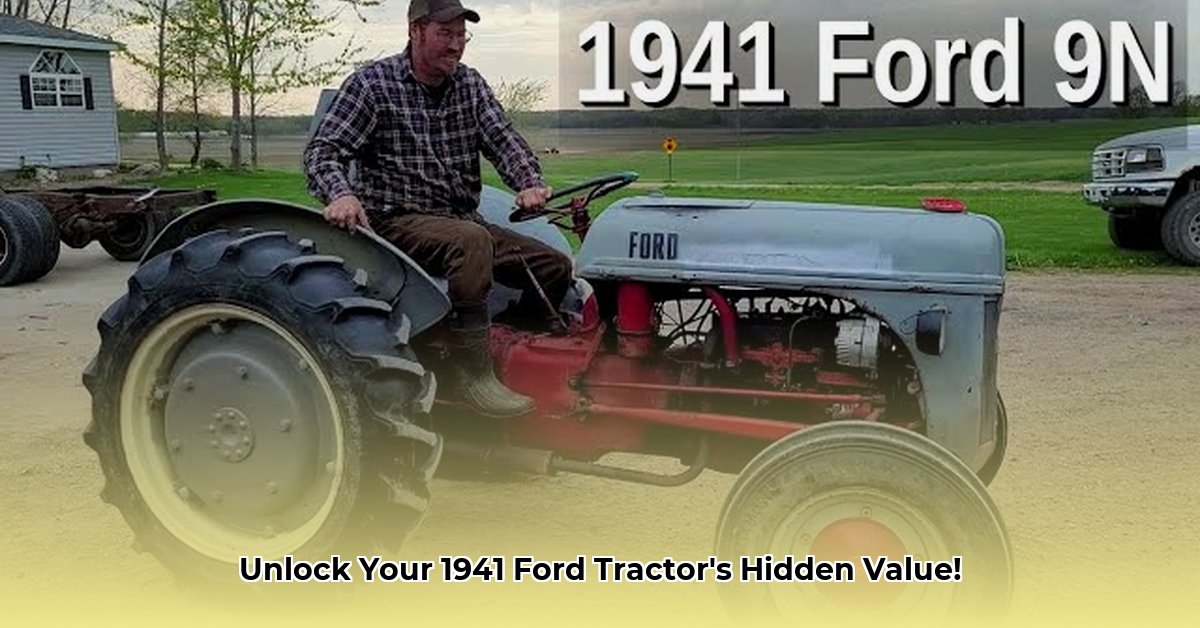
The 1941 Ford 9N tractor, a true icon of American agriculture, continues to fascinate collectors and farmers alike. But determining its value can be surprisingly complex. This comprehensive guide navigates the intricacies of Ford 9N valuation, restoration, and practical operation, providing insights for both seasoned enthusiasts and newcomers. For more information on similar models, check out this helpful guide on Ford Tractor Values.
Understanding 1941 Ford 9N Tractor Values
The price of a 1941 Ford 9N tractor varies dramatically, ranging from a few hundred dollars for a project tractor requiring extensive restoration to well over $15,000 for a meticulously restored showpiece. Several key factors influence this wide price range. "Condition is king," as many collectors reiterate, but many other elements come into play.
Key Factors Affecting Value
Several critical factors influence the value of a used Ford 9N tractor. These include:
- Condition: The extent of rust, missing parts, and overall wear and tear significantly impact value. A seized engine, for example, drastically reduces its worth. A thorough mechanical inspection is crucial.
- Completeness: Tractors in their original state, with all original components, command higher prices than those missing parts or with significant modifications. Original parts are highly sought after.
- Location: Shipping costs considerably affect the final price, and regional demand fluctuates. A tractor in a remote area may sell for less simply because of transportation expenses.
- Restoration Quality: The quality of any previous restoration is paramount. A professional restoration using original parts will always command a higher price than a hastily done restoration with aftermarket components. Many collectors prefer tractors that have been restored to original factory specifications.
Evaluating Your 1941 Ford 9N Tractor: A Buyer's Checklist
Before purchasing or selling a Ford 9N, a meticulous inspection is paramount. The following checklist highlights critical areas:
| Component | Inspection Points | What to Look For |
|---|---|---|
| Engine | Compression test, oil leaks, coolant leaks, oil pressure. | Strong compression, absence of leaks, consistent oil pressure at idle and under load. |
| Transmission | Shifting ease, gear engagement clarity. | Smooth, precise shifting; no grinding, whining, or slipping. |
| Hydraulic System | Lift capacity, leaks, responsiveness of controls. | Strong lift capacity, no leaks, responsive and smooth operation. |
| Electrical System | Battery condition, wiring integrity, functionality. | Fully charged battery, intact wiring, functioning lights and other electrical units. |
| Frame and Body | Rust, dents, structural integrity. | Minimal rust, few dents, solid frame and body with no major structural damage. |
| Tires | Tread depth, condition, any damage or dry rot. | Good tread depth, no significant signs of aging or damage. Factor in replacement costs. |
Restoring Your 1941 Ford 9N Tractor: A Step-by-Step Guide
Restoring a Ford 9N is a rewarding but challenging project. It requires significant time, mechanical aptitude, and access to parts.
- Complete Assessment: Begin with a thorough assessment, documenting its condition with photos and notes. This includes engine operation, hydraulics, and components.
- Parts Acquisition: Sourcing parts is crucial. Original parts are rare and expensive, while high-quality reproductions are more readily available. Online forums and specialized parts suppliers are valuable resources.
- Strategic Repair and Replacement: Prioritize repairs. Focus on essential systems (engine, transmission) before tackling cosmetic issues.
- Meticulous Reassembly: Clean and meticulously prepare all parts for reinstallation. Accuracy and precision are paramount.
- Rigorous Testing: Once reassembled, thoroughly test all systems. This ensures proper functionality and identifies any remaining problems before moving on to the next step.
Farming with a 1941 Ford 9N: Practical Considerations
While undeniably charming, a 1941 Ford 9N is not a modern tractor. Reduced horsepower and efficiency compared to modern equipment should be expected. Maintenance will require more time and effort, and parts may be more challenging to source. Carefully weigh the nostalgic appeal against practicality before deciding whether it suits your agricultural needs. "Is the sentimental value worth the increased maintenance?" is a question many farmers ask themselves.
Conclusion: A Piece of History
The 1941 Ford 9N tractor is a unique blend of history, robust mechanics, and collectable value. However, both buyers and sellers should approach it with realistic expectations. A thorough inspection is absolutely crucial. By utilizing this guide, enthusiasts and farmers can make informed decisions about this iconic piece of agricultural history. Remember, thorough research and a realistic appraisal are key to successful ownership.
Key Takeaways:
- Value depends significantly on condition, originality, and location. Even a well-maintained tractor can be a rewarding investment.
- Differentiating original and replacement parts is crucial for accurate valuation.
- A thorough pre-purchase inspection is non-negotiable. Market variations significantly influence pricing.
- A realistic assessment of your needs is paramount.